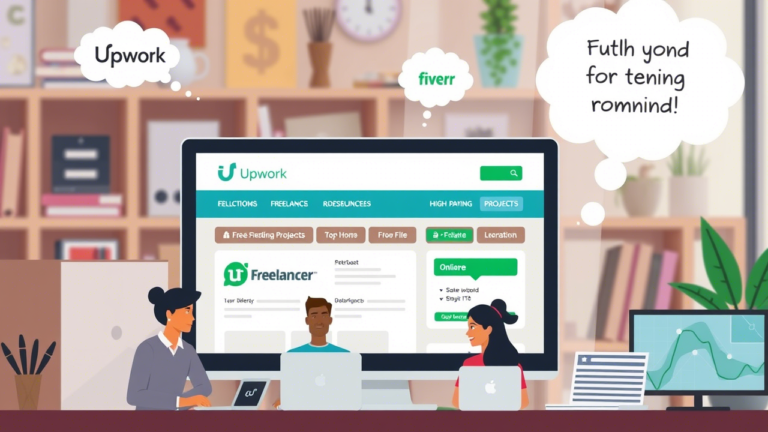Video Editing
Video Editing
Video editing is a highly creative and in-demand freelancing job that allows you to work from anywhere in the world. With the rise of video content on platforms like YouTube, TikTok, Instagram, and corporate websites, the need for skilled video editors has skyrocketed. As a freelance video editor, you can work on a variety of projects, from short social media clips to full-length films, and help clients bring their vision to life.
Why Choose Video Editing?
- High Demand: Businesses, content creators, and media companies need video editors to produce engaging content.
- Creative Freedom: Express your creativity while working on diverse projects.
- Flexibility: Work from anywhere and set your own schedule.
- Lucrative Earnings: Skilled editors can charge premium rates for their work.
- Portfolio Building: Create a strong portfolio that showcases your talent and attracts high-paying clients.
Types of Video Editing Jobs
- Social Media Content: Editing short videos for platforms like Instagram, TikTok, and YouTube.
- Corporate Videos: Creating promotional videos, training materials, or event highlights for businesses.
- Film and TV Editing: Working on independent films, documentaries, or television shows.
- Music Videos: Editing videos for musicians and bands.
- Wedding and Event Videos: Creating highlight reels for weddings, parties, or corporate events.
- Animation and Motion Graphics: Adding animated elements or motion graphics to videos.
- Color Grading and Special Effects: Enhancing videos with color correction, visual effects, or transitions.
How to Get Started in Video Editing
- Learn the Basics: Familiarize yourself with video editing software like Adobe Premiere Pro, Final Cut Pro, or DaVinci Resolve.
- Build a Portfolio: Create sample videos or edit personal projects to showcase your skills.
- Choose a Niche: Focus on a specific type of video editing, such as social media or corporate videos.
- Join Freelancing Platforms: Sign up on platforms like Upwork, Fiverr, or Behance to find clients.
- Network: Connect with potential clients on LinkedIn, social media, or through local film communities.
Tools for Video Editors
- Editing Software: Adobe Premiere Pro, Final Cut Pro, DaVinci Resolve, or iMovie.
- Motion Graphics Tools: Adobe After Effects or Blender for animations and effects.
- Audio Editing Tools: Adobe Audition or Audacity for sound design and mixing.
- Stock Footage Platforms: Websites like Shutterstock or Pexels for additional video resources.
- Collaboration Tools: Frame.io or Wipster for sharing and reviewing projects with clients.
Tips for Success in Video Editing
- Stay Updated: Keep up with the latest editing trends, software updates, and techniques.
- Understand Client Needs: Communicate effectively with clients to deliver videos that meet their expectations.
- Focus on Storytelling: Create videos that tell a compelling story and engage the audience.
- Deliver on Time: Meet deadlines to build trust and maintain strong client relationships.
- Build a Strong Portfolio: Showcase your best work to attract high-paying clients.
Earning Potential in Video Editing
The earning potential for freelance video editors varies based on experience, project complexity, and client type. Beginners may charge $20 to $50 per hour, while experienced editors can earn $75 to $150+ per hour. Some editors also charge per project, with rates ranging from $500 to $5,000 or more for high-quality work.
Challenges in Video Editing
- Competition: The field is highly competitive, so standing out requires a strong portfolio and niche expertise.
- Client Expectations: Managing client expectations and handling revisions can be challenging.
- Technical Issues: Working with large files and complex software can be time-consuming and demanding.
How to Overcome Challenges
- Specialize: Focus on a specific niche, such as social media or corporate videos, to differentiate yourself.
- Set Clear Contracts: Define project scope, timelines, and revision limits with clients to avoid misunderstandings.
- Invest in Equipment: Use high-quality hardware and software to improve efficiency and deliver professional results.
Real-Life Success Stories
- Sarah Johnson: A freelance video editor who started by editing wedding videos and now works with major brands, earning over $100,000 annually.
- Mike Thompson: A motion graphics artist who transitioned from a corporate job to freelancing and now creates animations for YouTube creators, earning $80,000 per year.
Future of Video Editing
The demand for video editors is expected to grow as video content continues to dominate online platforms. Emerging trends like virtual reality (VR), augmented reality (AR), and AI-powered editing tools will create new opportunities for editors who can adapt to these technologies.
Conclusion
Video editing is a dynamic and rewarding freelancing job that offers endless opportunities for creativity and professional growth. Whether you’re editing social media clips, corporate videos, or full-length films, there’s a niche for every editor. By honing your skills, building a strong portfolio, and delivering exceptional work, you can thrive as a freelance video editor and enjoy the freedom of working from anywhere in the world. Start your journey today and unlock the potential of freelancing in the exciting world of video editing!





